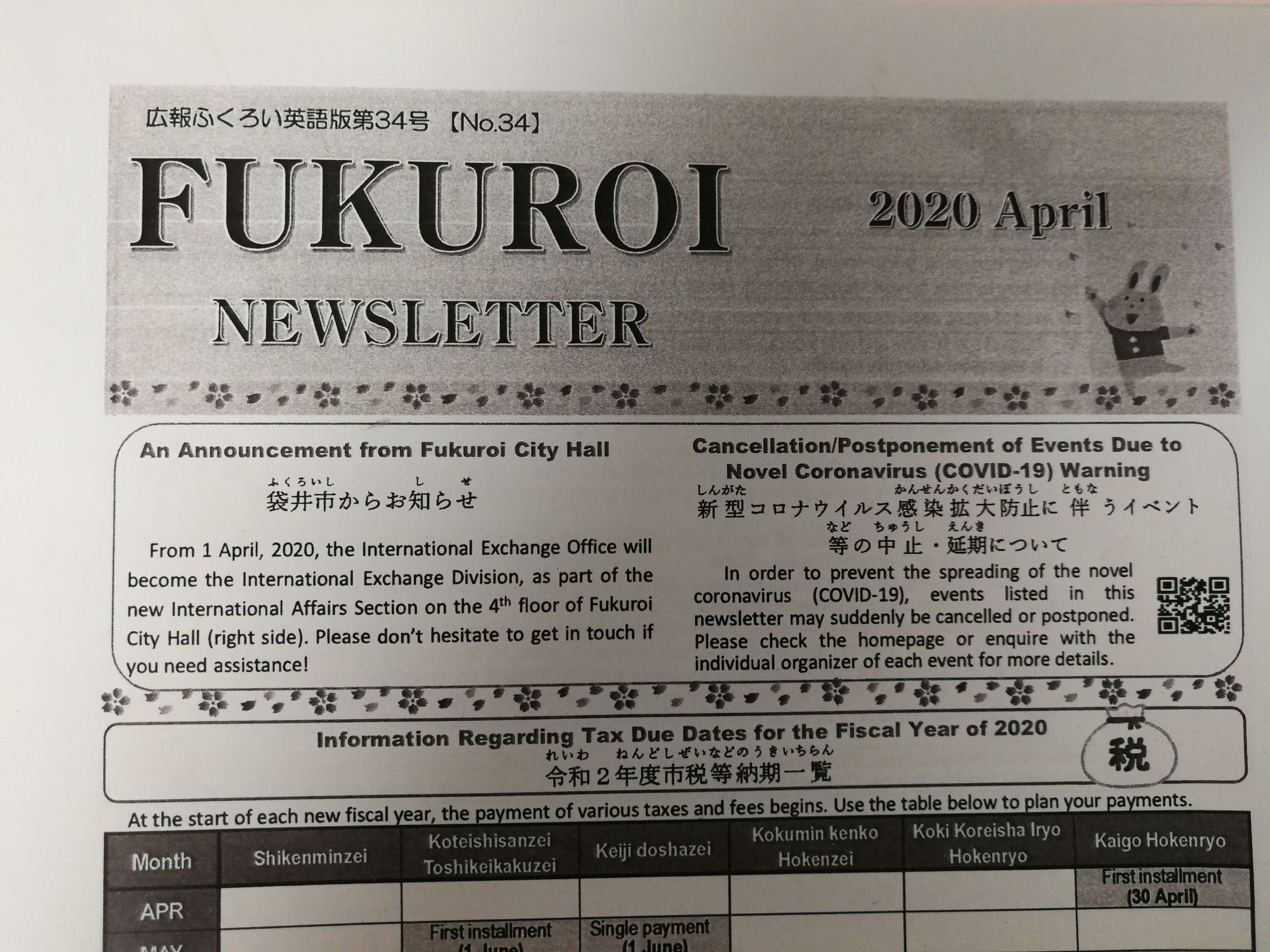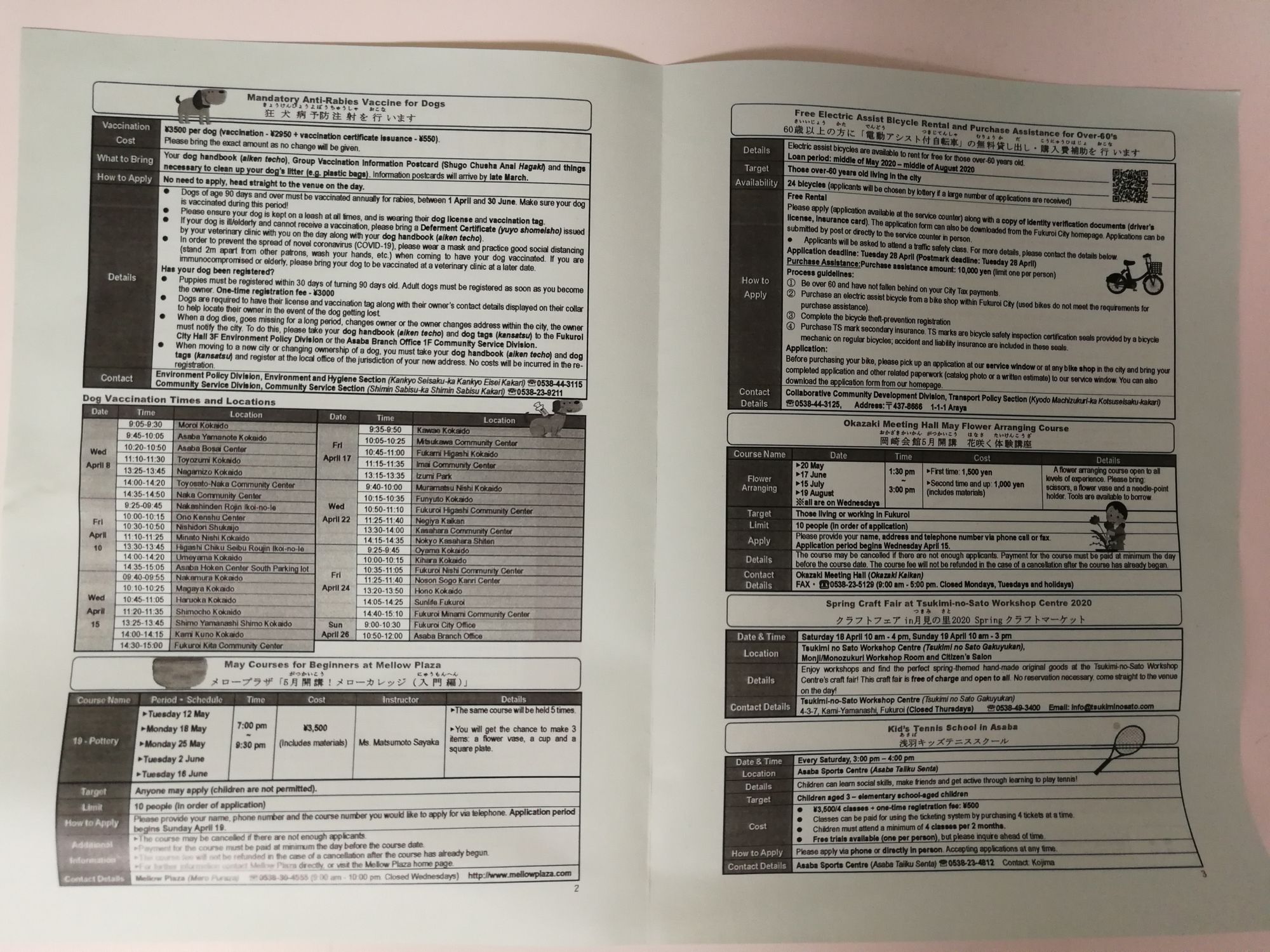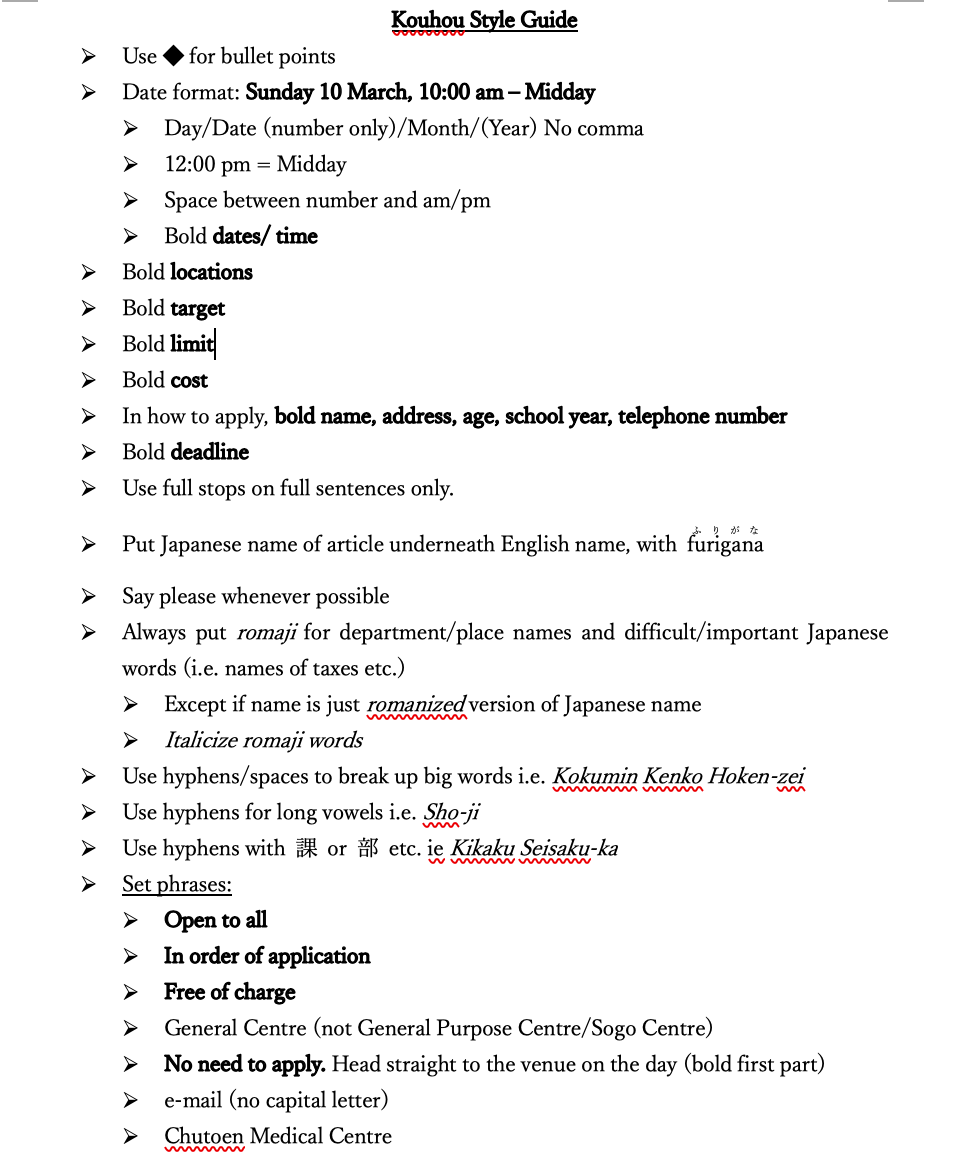Style Guides

It’s been pretty quiet in my office lately, so I’m taking this opportunity to redo the style guide that I have been using for translating the monthly newsletter. I hope I can expand this style guide to be used for all the Japanese -> English translations our office produces.

What is a Style Guide?
Shakti Enterprise describes a style guide as “not a how to translate but what should be looked into before translating”. It is a document that serves as a reference to translators to help keep all of the work produced by a company/organisation consistent. Style guides are incredibly important to both translators and companies, as consistency is paramount to brand identity. In the case of my office’s monthly newsletter, consistency is important in preventing confusion for the people readiing. It wouldn’t do to use one term to describe something one month and have it described with a completely different term the next month. Additionally, I feel like even “aesthetic consistency” is important in making sure the newsletter has a professional look and feel to it.
Here is the old style guide:

As I used to translate the newsletter by myself, I initially made this style guide to use as a reference for myself only but now that I share the work with my American co-worker, I feel it would be a good idea to refresh some points. I also would like to bring our city in line with the guidelines issued by Shizuoka Prefecture. I also need to make sure I don’t create a style guide that’s too long/restrictive, or I’ll end up making something counter-intuitive. After all, style guide is supposed to help speed up the translation/editing process.
New Style Guide
Here is the new style guide along with my reasoning for each point:
· Use any bullet point for bullet points so long as it is kept consistent. When space is tight, use the smallest circle
I used to ask for ◆ for all bullet points (to be fancy) but it’s something that me and my co-worker never stuck to. Additionally, space is often very tight as we have to condense a lot of articles down to what is essentially two and a half A4 pages after titles and headings have been added so it is better to save space where we can.
· Date format:
o Day/Date (number only, no th/st)/Month/Year – no comma.
o Japanese era year names should have the western calendar equivalent provided in brackets next to it. If the date is in brackets already, put the western year equivalent in square brackets inside the other brackets
§ Example :
(Friday 19 July Meiji 1 [1868])
This format is largely unchanged from previous editions of the newsletter but I wanted to add a bit of extra clarity around Japanese era names as I recently had a bit of trouble with deciding on a format in another translation.
· Time format:
o Use 12 hour clock format, with am and pm in between.
o Add a space between number and am/pm. – instead of ~ between times.
o 正午/12 pm = Midday
§ Example:
10 am – Midday
The newsletter has always used a 12 hour clock format for times with am and pm. I think my predecessors decided this to prevent ambiguity. The word “正午” (noon, midday) often appears often so to be clear I translate it as “Midday”.
· Bold dates and times
· Bold locations
· Bold target
“対” is translated as “target” and refers to the target audience of the article.
· Bold limit
The limit refers to how many people are allowed to attend an event advertised in the newsletter.
· Bold opening and ending dates of deadlines
· In how to apply section bold all required information (ie name, address, age, etc).
Basically, all important information that needs attention drawn to it should be bolded.
· Use full stops on full sentences only
I really hate full stops on little half sentences. I try to avoid it at all costs. If something is just stating the limit or the target, there is no need for a full stop.
· Say please whenever possible
This is just a personal preference of mine. A bit of politeness goes a long way!
· Put the Japanese name of article underneath the English name. Put furigana over the kanji.
This is has been the standard format of the newsletter since our office started translating it 4 years ago.
· For organisation’s/places/people’s names:
o When romanising names, do not put in extra u’s or vowels with macrons over them to denote elongated vowels.
o Person’s name format:
§ Title (Mr/Ms/Governor/Mayor/Minister etc)/First Name/Last Name.
§ Example:
Vice Commander Toshizo Hijikata (Not Hijikata Toshizou or Hijikata Toshizō)
Ms Chizuru Yukimura
o If the person’s gender is unknown and cannot be found out, simply omit the title.
o Always put romaji in brackets in italics after the English name of the contact. Ensure to double check for an official English name for the contact in previous editions of the newsletter or in the English translation of the city hall departments.
o Put a – before “ka” and “kakari” in romanisation of department/division names.
o Always render 係 as as “kakari” and not “gakari”.
o Kanji compounds should be separated into individual words where possible.
§ Example:
General Affairs Department, International Affairs Department, International Relations Division (Sogo-bu, Kokusai-ka, Kokusai Koryu-kakari)
Shizuoka Prefecture’s style guide states that extra u’s or the vowel with a macron over it should not be used to denote elongated vowel sounds. It was nice to get some proper guidance on this matter as I’ve bounced around on styles for a while.
Every year create a new translation for the departments and divisions within the city hall. For non-city hall contacts, many of them have previously appeared in the newsletter before so I just go back to old editions. If not, I usually just go to Google Maps or the contact’s official website. If I find nothing there, I then have to come up with an English name for the contact myself or just simply use the romaji.
Put the romaji of key documents/details (ie names of taxes) in brackets and italics next to the English translation
Example
Driver's License (Unten Menkyo)
Believe it or not, this only occurred to me after being given an English menu with no Japanese on it at a restaurant. I knew the English name of the dish, but I didn't know what it was called in Japanese so it made it hard to order. If the name of the dish had been written in romaji or even hirigana/kanji with furigana next to the translation, there would have been no problem. Often newsletter articles will call for people to bring documents with them when applying for certain services, or they may be called to pay certain taxes. While knowing the English translation is important, knowing the Japanese name is equally important for someone coming to the city hall to ask for help.
· Key Set Phrases:
o 市役所 – City Hall (not City Office)
o 申込不要。直接会場へ – No need to apply. Head straight to the venue on the day.
o どなたでも – Open to all
o 料 – Cost (May sometimes be rendered as “fee”)
o 申 – How to Apply
o 定 – Limit
o 先着順 – (in order of application)
o 申込多数の場合、抽選 – If there are many applications, participants will be chosen by raffle. (If needs be substitute another word for participant.)
o 総合センター – General Center (not General Purpose/Sogo Center)
These phrases appear widely in almost every edition of the newsletter.
The newsletter has a lot of repeat articles that reoccur monthly or yearly. If I had the resources, I’d just use a translation memory tool (TM) to do it but the closest thing I have to that kind of technology is a file containing all of the previous editions of the newsletter that I can search through for repeat articles. Unfortunately, my office would not agree to purchasing any TM software for me and the (very very old) laptop I work with is so restricted it wouldn’t allow me to install pirated software, so I guess I’ll just have to keep doing it by hand for the foreseeable future.
Once I get my co-worker to look over this and make some suggestions, it should be ready to go for next month's newsletter. I really hope that this style guide will be useful not only to me and my current co-workers, but to CIRs that will work in my office in the future too.
Thanks very much for reading!
- Rachael